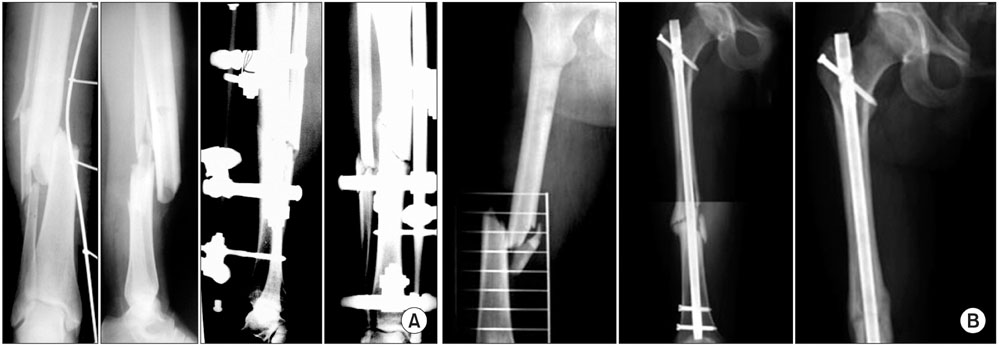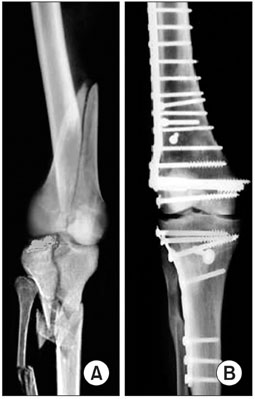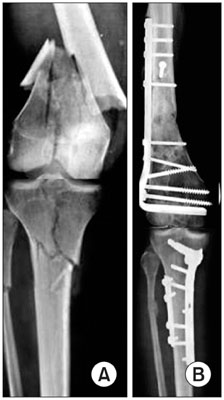Clin Orthop Surg.
2011 Jun;3(2):133-139. 10.4055/cios.2011.3.2.133.
Surgical Management of Ipsilateral Fracture of the Femur and Tibia in Adults (the Floating Knee): Postoperative Clinical, Radiological, and Functional Outcomes
- Affiliations
-
- 1Orthopedic Surgery Department, Zagazig University Faculty of Medicine, Zagazig, Egypt. alaa58hegazy@hotmail.com
- KMID: 1719310
- DOI: http://doi.org/10.4055/cios.2011.3.2.133
Abstract
- BACKGROUND
This study evaluated the outcomes of surgical management of ipsilateral femoral and tibial fractures in adults.
METHODS
Fifteen patients (13 men, 2 women; mean age, 34.8 years; range, 18 to 65 years) were enrolled in this study. The fractures types were classified according to the classification by Fraser et al. as follows: type I (5), type IIa (3), IIb (4), IIc (3). Femur fractures were treated using locked intramedullary nails, plate-screws, or dynamic condylar screws, and tibia fractures were treated with an external fixator (in open fractures), or plate-screws, and locked intramedullary nailing. The mean follow-up duration was 2.2 years (range, 1.3 to 4 years).
RESULTS
The extent of bony union according to the Karlstrom criteria was as follows: excellent, 8; good, 4; acceptable, 2; poor, 1.
CONCLUSIONS
The associated injuries and type of fracture (open, intra-articular, comminution) are prognostic factors in a floating knee. The best management of the associated injuries for good final outcome involves intramedullary nailing of both the fractures and postoperative rehabilitation.
Keyword
MeSH Terms
Figure
Reference
-
1. Lundy DW, Johnson KD. "Floating knee" injuries: ipsilateral fractures of the femur and tibia. J Am Acad Orthop Surg. 2001. 9(4):238–245.
Article2. Jeong GK, Pettrone SK, Liporace FA, Meere PA. "Floating total knee": ipsilateral periprosthetic fractures of the distal femur and proximal tibia after total knee arthroplasty. J Arthroplasty. 2006. 21(1):138–140.
Article3. Hayes JT. Multiple fractures in the same extremity: some problems in their management. Surg Clin North Am. 1961. 41(5):1379–1388.
Article4. Omer GE Jr, Moll JH, Bacon WL. Combinded fractures of the femur and tibia in a single extremity: analytical study of cases at Brooke General Hospital from 1961-to1967. J Trauma. 1968. 8(6):1026–1041.5. Bansal VP, Singhal V, Mam MK, Gill SS. The floating knee: 40 cases of ipsilateral fractures of the femur and the tibia. Int Orthop. 1984. 8(3):183–187.
Article6. Singh Chhina JP, Kapila R. Ipsilateral fractures of femur and tibia: a clinical study. Indian J Orthop. 1999. 33(3):159–161.7. Fraser RD, Hunter GA, Waddell JP. Ipsilateral fracture of the femur and tibia. J Bone Joint Surg Br. 1978. 60(4):510–515.
Article8. Behr JT, Apel DM, Pinzur MS, Dobozi WR, Behr MJ. Flexible intramedullary nails for ipsilateral femoral and tibial fractures. J Trauma. 1987. 27(12):1354–1357.
Article9. Gustilo RB, Anderson JT. Prevention of infection in the treatment of one thousand and twenty-five open fractures of long bones: retrospective and prospective analyses. J Bone Joint Surg Am. 1976. 58(4):453–458.
Article10. Karlstrom G, Olerud S. Ipsilateral fracture of the femur and tibia. J Bone Joint Surg Am. 1977. 59(2):240–243.
Article11. Adamson GJ, Wiss DA, Lowery GL, Peters CL. Type II floating knee: ipsilateral femoral and tibial fractures with intraarticular extension into the knee joint. J Orthop Trauma. 1992. 6(3):333–339.12. Ratliff AH. Fractures of the shaft of the femur and tibia in the same limb. Proc R Soc Med. 1968. 61(9):906–908.13. Ostrum RF. Treatment of floating knee injuries through a single percutaneous approach. Clin Orthop Relat Res. 2000. 375:43–50.
Article14. Kao FC, Tu YK, Hsu KY, Su JY, Yen CY, Chou MC. Floating knee injuries: a high complication rate. Orthopedics. 2010. 33(1):14.
Article15. Dwyer AJ, Paul R, Mam MK, Kumar A, Gosselin RA. Floating knee injuries: long-term results of four treatment methods. Int Orthop. 2005. 29(5):314–318.
Article16. Theodoratos G, Papanikolaou A, Apergis E, Maris J. Simultaneous ipsilateral diaphyseal fractures of the femur and tibia: treatment and complications. Injury. 2001. 32(4):313–315.
Article17. Oh CW, Oh JK, Min WK, et al. Management of ipsilateral femoral and tibial fractures. Int Orthop. 2005. 29(4):245–250.
Article18. Ríos JA, Ho-Fung V, Ramírez N, Hernández RA. Floating knee injuries treated with single-incision technique versus traditional antegrade femur fixation: a comparative study. Am J Orthop (Belle Mead NJ). 2004. 33(9):468–472.19. Schiedts D, Mukisi M, Bouger D, Bastaraud H. Ipsilateral fractures of the femoral and tibial diaphyses. Rev Chir Orthop Reparatrice Appar Mot. 1996. 82(6):535–540.20. Szalay MJ, Hosking OR, Annear P. Injury of knee ligament associated with ipsilateral femoral shaft fractures and with ipsilateral femoral and tibial shaft fractures. Injury. 1990. 21(6):398–400.
Article21. Paul GR, Sawka MW, Whitelaw GP. Fractures of the ipsilateral femur and tibia: emphasis on intra-articular and soft tissue injury. J Orthop Trauma. 1990. 4(3):309–314.
Article22. Gregory P, DiCicco J, Karpik K, DiPasquale T, Herscovici D, Sanders R. Ipsilateral fractures of the femur and tibia: treatment with retrograde femoral nailing and unreamed tibial nailing. J Orthop Trauma. 1996. 10(5):309–316.
Article23. Yokoyama K, Tsukamoto T, Aoki S, et al. Evaluation of functional outcome of the floating knee injury using multivariate analysis. Arch Orthop Trauma Surg. 2002. 122(8):432–435.
Article24. Arslan H, Kapukaya A, Kesemenli CC, Necmioglu S, Subasi M, Coban V. The floating knee in adults: twenty-four cases of ipsilateral fractures of the femur and the tibia. Acta Orthop Traumatol Turc. 2003. 37(2):107–112.25. Hee HT, Wong HP, Low YP, Myers L. Predictors of outcome of floating knee injuries in adults: 89 patients followed for 2-12 years. Acta Orthop Scand. 2001. 72(4):385–394.
Article26. Hung SH, Lu YM, Huang HT, et al. Surgical treatment of type II floating knee: comparisons of the results of type IIA and type IIB floating knee. Knee Surg Sports Traumatol Arthrosc. 2007. 15(5):578–586.
Article27. Rethnam U, Yesupalan RS, Nair R. Impact of associated injuries in the floating knee: a retrospective study. BMC Musculoskelet Disord. 2009. 10:7.
Article
- Full Text Links
- Actions
-
Cited
- CITED
-
- Close
- Share
- Similar articles
-
- Surgical Treatment of Ipsilateral Fracture of the Femur and Tibia("Floating Knee")
- Treatment of Ipsilateral Fracture of the Femur and Tibia("Floating Knee")
- Treatment of Ipsilateral Fracture of the Femur and Tibia
- Ipsilateral Fractures of the Femur and Tibia
- The Clinical Study on Ipsilateral Fracture of the Femur and Tibia





